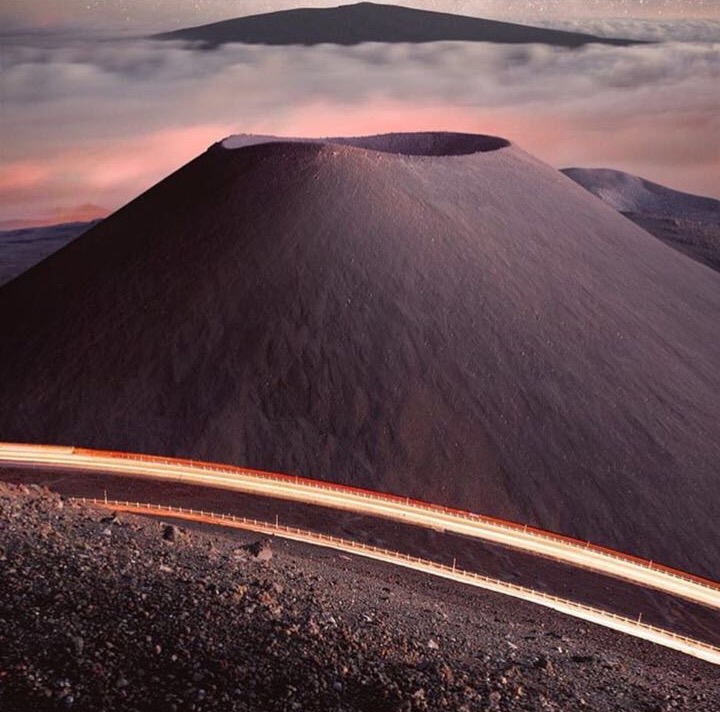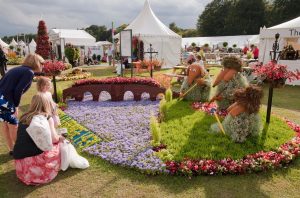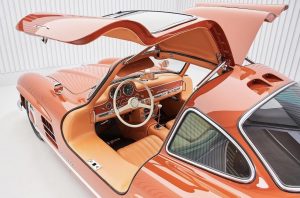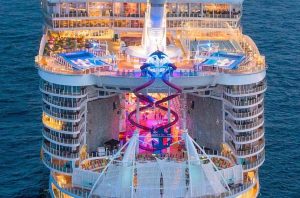
Mauna Kea (English pronunciation: /ˌmɔːnə ˈkeɪ.ə/ or /ˌmaʊnə ˈkeɪ.ə/, Hawaiian: [ˈmɐwnə ˈkɛjə]), is a dormant volcano on the island of Hawaii. Standing 4,207 m (13,802 ft) above sea level, its peak is the highest point in the state of Hawaii. Much of the mountain is under water; when measured from its oceanic base, Mauna Kea is over 10,000 m (33,000 ft) tall. Mauna Kea is about a million years old, and has thus passed the most active shield stage of life hundreds of thousands of years ago. In its current post-shield state, its lava is more viscous, resulting in a steeper profile. Late volcanism has also given it a much rougher appearance than its neighboring volcanoes; contributing factors include the construction of cinder cones, the decentralization of its rift zones, the glaciation on its peak, and the weathering effects of the prevailing trade winds. Mauna Kea last erupted 6,000 to 4,000 years ago and is now considered dormant.
In Hawaiian mythology, the peaks of the island of Hawaiʻi are sacred. An ancient law allowed only high-ranking aliʻi to visit its peak. Ancient Hawaiians living on the slopes of Mauna Kea relied on its extensive forests for food, and quarried the dense volcano-glacial basalts on its flanks for tool production. When Europeans arrived in the late 18th century, settlers introduced cattle, sheep and game animals, many of which became feral and began to damage the mountain’s ecological balance. Mauna Kea can be ecologically divided into three sections: an alpine climate at its summit, a Sophora chrysophylla–Myoporum sandwicense (or māmane–naio) forest on its flanks, and an Acacia koa–Metrosideros polymorpha (or koa–ʻōhiʻa) forest, now mostly cleared by the former sugar industry, at its base. In recent years, concern over the vulnerability of the native species has led to court cases that have forced the Hawaii Department of Land and Natural Resources to eradicate all feral species on the mountain.
With its high elevation, dry environment, and stable airflow, Mauna Kea’s summit is one of the best sites in the world for astronomical observation. Since the creation of an access road in 1964, thirteen telescopes funded by eleven countries have been constructed at the summit. The Mauna Kea Observatories are used for scientific research across the electromagnetic spectrum from visible light to radio, and comprise the largest such facility in the world. Their construction on a landscape considered sacred by Native Hawaiians continues to be a topic of debate.
Recreation:
Mauna Kea’s coastline is dominated by the Hamakua Coast, an area of rugged terrain created by frequent slumps and landslides on the volcano’s flank.The area includes several recreation parks including Kalopa State Recreation Area, Wailuku River State Park and Akaka Falls State Park.
There are over 3,000 registered hunters on Hawaii island, and hunting, for both recreation and sustenance, is a common activity on Mauna Kea. A public hunting program is used to control the numbers of introduced animals including pigs, sheep, goats, turkey, pheasants, and quail. The Mauna Kea State Recreation Area functions as a base camp for the sport. Birdwatching is also common at lower levels on the mountain. A popular site is Kīpuka Pu’u Huluhulu, a kīpuka on Mauna Kea’s flank that formed when lava flows isolated the forest on a hill.
Mauna Kea’s great elevation and the steepness of its flanks provide a better view and a shorter hike than the adjacent Mauna Loa. The high elevation with its risk of altitude sickness, weather concerns, steep road grade, and overall inaccessibility make the volcano dangerous and summit trips difficult. Until the construction of roads in the mid-20th century, only the hardy visited Mauna Kea’s upper slopes; hunters tracked game animals, and hikers traveled up the mountain. These travelers used stone cabins constructed by the Civilian Conservation Corps in the 1930s as base camps, and it is from these facilities that the modern mid-level Onizuka Center for International Astronomy telescope support complex is derived. The first Mauna Kea summit road was built in 1964, making the peak itself accessible to larger numbers of people.
Today, multiple hiking trails exist, including the Mauna Kea Trail, and by 2007 over 100,000 tourists and 32,000 vehicles were going each year to the Visitor Information Station (VIS) adjacent to the Onizuka Center for International Astronomy. The Mauna Kea Access Road is paved up to the Center at 2,804 m (9,199 ft). One study reported that around a third of visitors and two thirds of professional astronomers working on the mountain have experienced symptoms of acute altitude sickness; visitors traveling up the volcano’s flanks are advised to stop for at least half an hour and preferably longer at the visitor center to acclimate to the higher elevation. It is strongly recommended to use a four-wheel drive vehicle to drive all the way to the top. Brakes often overheat on the way down and there is no fuel available on Mauna Kea. A free Star Gazing Program is held at the VIS every night from 6-10 pm. Between 5,000 and 6,000 people visit the summit of Mauna Kea each year, and to help ensure safety, and protect the integrity of the mountain, a ranger program was implemented in 2001.
Before you make the trek up the mountain, there are a few things you need to know. It’s recommended that children under 16, pregnant women, and those in poor health not go higher than the Onizuka Center for International Astronomy Visitor Information Station (VIS), at 9,200 feet.
Mauna Kea Visitor Information Station
The Visitor Information Station is an interesting stop in its own right — it’s the best amateur observation site on the globe, with a handful of telescopes for viewing. Visitors should note that the telescopes at the summit are for the astronomers only, but guests who make it that high can still enjoy the diamond-studded sky and see more stars than they’ve likely ever seen before. The Onizuka Center holds free nightly stargazing sessions here as well from 6 to 10 p.m.
Mauna Kea Summit Tours
On the weekends, the VIS offers escorted summit tours, heading up the mountain in a caravan. If you don’t want to make the drive yourself, opt for a handful of tours that will take you to and from the summit.
Altitude Sickness
Altitude sickness — including shortness of breath and impaired judgment — is a big possibility so proceed with caution, stop at the VIS for at least half-an-hour to acclimate, and don’t overexert yourself.
Snow Boarding in Hawaii
A special note for extreme adventurers: You have to be in good shape, but snowboarding is possible in Hawaii. There are no lifts, so you must walk up the mountainside on foot, but Mauna Kea sees its fair share of brave boarders who are willing to make the effort.
You’ll even see a few locals carting home a truck bed full of snow so keiki (children) can enjoy making a snowman in their front yards at sea level.




